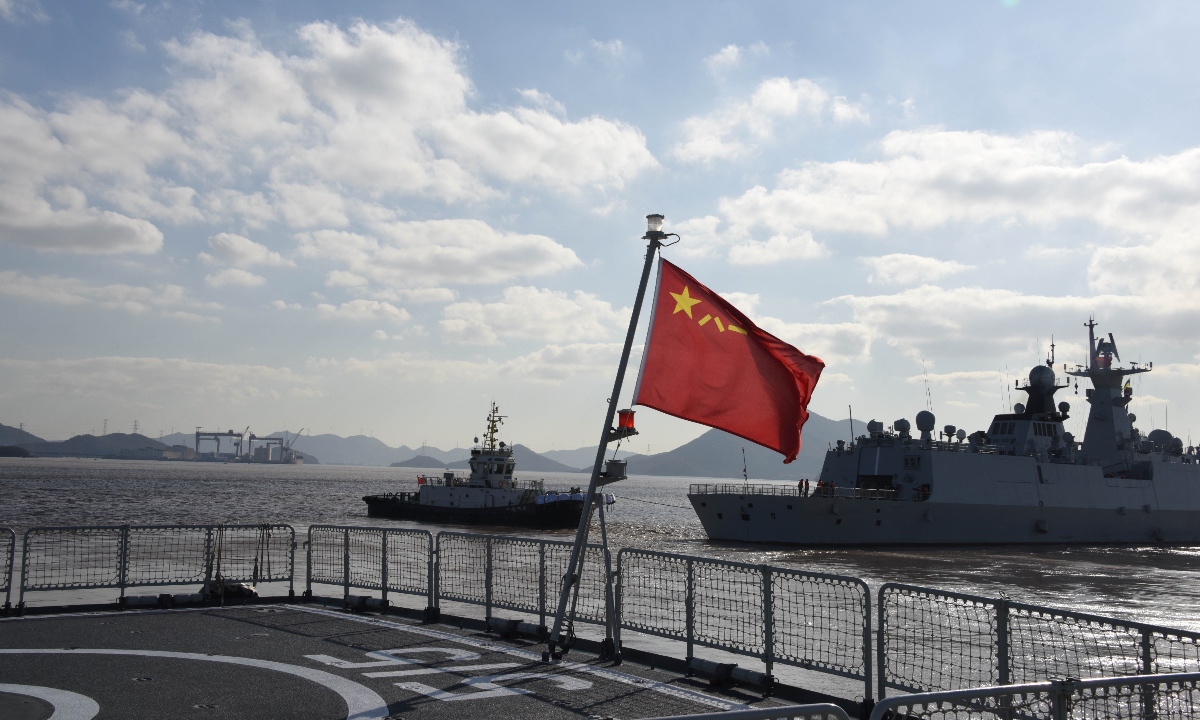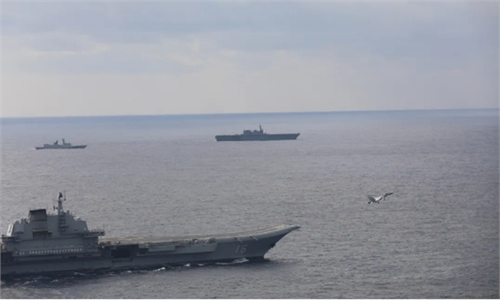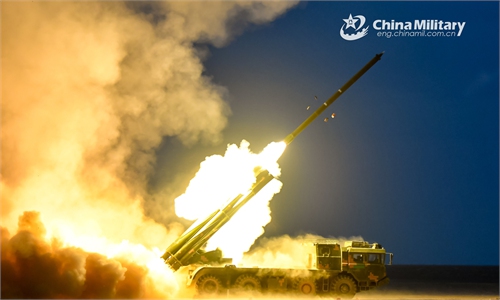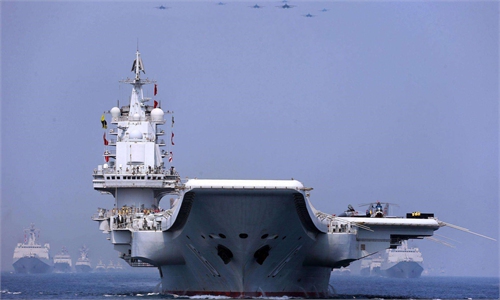China, Russia to hold joint naval drill in East China Sea, displaying capability amid US, Japanese provocations
Multiple concurrent training operations reflect PLA Navy’s rapid growth: experts

A Chinese naval fleet taking part in the China-Russia Joint Sea 2022 military exercise weighs anchor from a military port in Zhoushan, East China's Zhejiang Province on December 20, 2022. Photo: Xinhua
China and Russia will hold a week-long joint naval drill in the East China Sea starting Wednesday, in a move which analysts said on Tuesday displays the two countries’ capabilities in tackling maritime security threats and safeguarding peace and stability at a complicated time when the US keeps promoting its “Indo-Pacific Strategy” and Japan has broken away from its defense-only principle, instigating tensions in the Taiwan Straits.
Based on the annual military cooperation schedule between the Chinese and Russian armed forces, the navies of the two countries will hold the Joint Sea 2022 military exercise in the waters east of the coastline stretching from Zhoushan to Taizhou, East China’s Zhejiang Province from Wednesday to December 27, China’s Ministry of National Defense said in a press release on Tuesday.
The joint exercise aims to display the two sides’ determination and capability in strengthening efforts to jointly deal with maritime security threats, as well as safeguard international and regional peace and stability, and to further deepen the China-Russia comprehensive strategic partnership of coordination for a new era, the Chinese Defense Ministry said.
Russia’s Ministry of Defense said in a press release on Monday that the main goal of the exercise is to strengthen naval cooperation between the two countries and maintain peace and stability in the Asia-Pacific region.
Joint naval exercises between China and Russia have become regular and routine, observers said. Last year, the Joint Sea 2021 was held in the Sea of Japan off the coast of Russia in waters near Peter the Great Gulf, and this year they have moved to the East China Sea off the coast of China. Previously there were also drills in places like the Yellow Sea.
Such a rotation method will allow the Chinese and Russian navies to get familiar with each other’s sea areas and achieve the best training results, Chinese military expert Song Zhongping told the Global Times on Tuesday.
It is an embodiment of the two militaries’ mutual trust, Song said.
The Joint Sea 2022 is also not the first joint naval operation between China and Russia this year. In September, after participating in the Russia-led Vostok-2022 strategic drills, a PLA Navy flotilla joined Russian warships in a joint naval patrol in the Pacific Ocean. The two navies have carried out two such joint patrols since 2021.
The latest joint drill, set in the East China Sea neighboring the island of Taiwan and Japan, comes at a time when Japan recently revised its defense strategies, breaking away from its strictly self-defense-only postwar principle and declaring plans to possess preemptive strike capability and cruise missiles.
Also, Western officials have continuously visited the island of Taiwan to provoke China on its core interests after US House Speaker Nancy Pelosi’s visit in August, and with the US continuing to sell arms to the island, tensions in the Taiwan Straits remain high.
The US Navy’s Nimitz carrier strike group was set to arrive in waters northeast of Guam by Tuesday, as it is expected to start a routine deployment in the West Pacific, taking the place of the USS Ronald Reagan aircraft carrier, according to the monitoring of the South China Sea Strategic Situation Probing Initiative, a Beijing-based think tank.
The US continues to promote its “Indo-Pacific Strategy,” with Japan’s security strategy amendment fusing into it. China and Russia are responsible for safeguarding peace and stability in the region, and that is why they must enhance military cooperation, Song said.
“The China-Russia joint drill is not aimed at a third party, but if some parties want to be targeted, then let it be so,” Song said.
The Chinese participating forces are from the People’s Liberation Army (PLA) Eastern and Northern theater commands, including the Type 052D destroyer Baotou, the Type 052C destroyer Jinan, the Type 054A frigates Binzhou and Yancheng, the Type 903A comprehensive supply ship Gaoyouhu, as well as a submarine, fixed wing early warning aircraft, anti-submarine patrol aircraft and vessel-borne helicopters, said Senior Captain Gao Xiucheng, a spokesperson of the PLA Navy, in a statement on Tuesday.
According to the Russian press release, the Russian Navy will be represented by the guided missile cruiser Varyag, the frigate Marshal Shaposhnikov and the Project 20380 corvettes Hero of the Russian Federation Aldar Tsydenzhapov and Sovershennyy, as well as aircraft and helicopters of the naval aviation forces of the Russian Pacific Fleet.
The two naval forces will conduct exercises including joint rocket and artillery firing at air targets, artillery firing at sea targets, joint anti-submarine operations with the practical use of weapons, joint blockade and joint rescue, according to releases by the two sides.
These multidimensional training courses cover the core elements in modern naval combat, a Beijing-based military expert who requested anonymity told the Global Times on Tuesday.
The Varyag, which is the flagship of the Russian Pacific Fleet, and the PLA Navy’s deployment of a submarine, which is supposed to be very secret, show the high level of cooperation and trust between the two navies, the expert said.
The two countries’ warships will rendezvous at noon on Wednesday and form a joint flotilla in the East China Sea, China Central Television reported on Tuesday.
Joint Sea 2022 marks the 10th anniversary since the first drill in this series in 2012, and it will become more realistic and innovative, promote the establishment of maritime joint patrol mechanism, and further push forward innovative, cooperative development and mutual trust between the two countries and the two navies, said Gao.
Simultaneous moves
Just as the China-Russia joint naval drill is about to start, a large number of main combat vessels of the PLA Navy, including the aircraft carrier Liaoning and three Type 055 10,000 ton-class large destroyers, are operating beyond the first island chain in the West Pacific for apparent exercises, according to Japan’s Defense Ministry, which reported the transits of those Chinese warships from the Miyako Strait and Osumi Strait last week.
In a move that analysts said could be a joint training operation, on Monday, two H-6J bombers of the PLA Navy flew from the East China Sea across the Miyako Strait into the West Pacific, to near the location where the Liaoning aircraft carrier group was sailing, before returning from the same course, Japan’s Defense Ministry Joint Staff said in a press release on the day.
The PLA Navy has been growing rapidly in terms of both the number and quality of warships, as well as qualified personnel and organizational capability, so it can hold multiple large-scale military exercises concurrently, experts said.
It also means that in real combat, the PLA Navy can engage multiple enemies in multiple regions simultaneously, analysts said.




